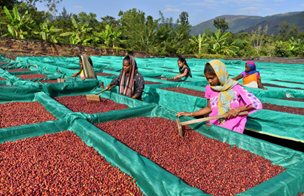

25th May 2023 (8 Topics)
Context
India has been a hub for the global spice, tea, and coffee trade for centuries, and its scale and diversity has grown significantly over the last three decades, increasing the share of high-value agricultural commodities in the agricultural sector.
Key highlights:
- The rise of sustainability initiatives in commodity value chains has acknowledged the environmental degradation caused by carbon emissions and injudicious use of water and chemicals.
- There are now reliable estimates of emissions per unit of production for several commodities.

What is an agri commodity of global significance?
- Agriculture commodities are often defined based on their orientation towards international demand and supply in the form of exports.
- India, as a major consumer and producer, needs to expand this understanding to include commodities that are actively imported, produce for domestic and international markets, and get significant attention within the policy and action spaces.
- Interventions in the production, trade and consumption of these commodities are likely to drive transformational impacts on environmental sustainability across the sector.
What are the challenges to sustainability?
- Organic coffee beans being processed at Naandi Foundation in Araku, Visakhapatnam, November 19, 2018.
- Against this background, ensuring that an agricultural commodity value chain is environmentally sustainable is a multi-dimensional challenge.
- Four dimensions in particular vex efforts to mitigate its environmental impact while benefiting farmers, processors, retailers, etc.

Nature of production:
- Firstly, Market and producer characteristics determine where responsible and effective practices can be implemented to have the greatest impact. For export-oriented commodities, export policies or consumer preferences can determine emissions.
- For smallholders, effective and low-cost certification can improve practices throughout the value chain, mitigating environmental impact and delivering price premiums.
- Coordinated policy action is needed to raise the floor to a minimum set of production, sourcing, and retailing standards.
- Secondly, the nature of production determines the type of intervention. Regional efforts have led to climate, biodiversity, and livelihood benefits while helping preserve our ecological heritage.
- For example, the introduction of biodiversity-friendly coffee in Karnataka has mitigated human-animal conflicts and the public attention on millets has helped widen demand across Indian and international consumers.
- Third, Strong governance mechanisms and policies can help transform commodity value chains by providing subsidies, market access, and infrastructural support to improve production, sourcing, and consumption.
- Fourth, the success of any environmental sustainability initiative hinges on getting actors like those who are most marginalised on board and providing them with adequate safety nets.
- These safety nets could take the form of rewarding compliance, committing to support farm-level flexibility, and evolving robust insurance mechanisms.
- These four dimensions make mitigating environmental impacts in agricultural commodity value chains difficult to achieve in practice, but they also present opportunities.
- If concerted and coordinated action is combined with the right kind of support systems while keeping equity and justice in mind, agricultural commodity value chains can deliver for India’s people and its environment.

More Articles


